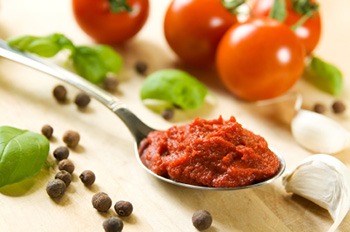It's easy to get answers about health and nutrition! Just send your question by email to [email protected] and Dr. Harlan will respond to selected questions of general interest. Answers will be posted in the Ask Dr. Gourmet newsletter (sign up now!) and archived in the Ask Dr. Gourmet section of the website.
Please note that the Ask Dr. Gourmet feature is restricted to questions regarding food and nutrition. Due to the many questions we receive, not all questions may be answered. For more specific questions about your individual health, please contact your doctor. About Timothy S. Harlan, MD, FACP, CCMS | Terms of Use | Privacy Policy
Ask Dr. Gourmet
Is the un-moldy part of an opened can of tomato paste safe to eat?
I have a question on a situation that everyone runs into:
If you remove the mold that forms atop an opened can of tomato paste, and carefully remove any visible moldy portions so that the next spoonful coming out doesn't touch any mold -- is it safe to use that paste? If you tasted it, and it tasted OK, I would assume it's still a bad idea to push your luck and say "Well it tastes OK, so I'll use it anyway?"
And yes, I'm asking this because I just tossed my umpteenth opened can of moldy paste, and am wondering if I could've used the OK-looking (and tasting) paste on the bottom of the can. But no, I haven't spread it on a slide and looked for microscopic remnants of mold on the can surface or in the paste itself.
Dr. Gourmet Says...

Your question is one that we have all probably asked at one time or another. The USDA and FDA use a test known as the "Howard Mold Count" to determine the amount of mold in products that you purchase. As you might expect those governmental agencies have regulations about the acceptable levels of mold in certain foods. As such, there may be some mold in the tomato paste when you open it that is now able to grow with the exposure to oxygen.
Refrigeration slows the growth of the mold but the longer the opened can is in the refrigerator, the greater the chance that mold will grow.
Most of the molds are benign and not likely to hurt you, but they are certainly going to affect flavor of the tomato paste. While the molds might not hurt you, I myself would not risk it.
We have had comments from several readers have posted ways to safely store the unused tomato paste for later use. One that might be effective is to spray the top of the tomato paste in the can with olive or other spray oil. That barrier of fat may help reduce the amount of oxygen exposure to the mold in the can.
Another is to freeze the tomato paste in one tablespoon dollops on a piece of waxed paper or a Silpat silicone sheet and then put those in a Ziplock bag. Rather than keeping a jar of paste in the refrigerator and taking the health risk, I would use one of their methods to store the unused paste (and have done so).
On the other hand, there's an even more convenient solution than freezing the unused, canned tomato paste. There are many manufacturers that sell tomato paste in a tube. Just squeeze out what you need and reclose the tube. This is widely available in many grocery stores, and while it's a little higher priced than a can of traditional tomato paste, none gets wasted. I use Amore brand. They also make other great cooking pastes including versions with basil, sun-dried tomato and tomato garlic paste.
Here are some recipes to make use of your tomato paste:
Pasta with Tomato Caraway Sauce
Bean and Tomato Pasta Bake
Stuffed Chicken with Tomato and Cheese
Salmon with Spanish Beans and Rice
Boston Baked Beans
Roasted Whitefish with Quick Ratatouille
Jollof Rice
Penne Arrabbiata
Timothy S. Harlan, MD, FACP, CCMS
Dr. Gourmet
